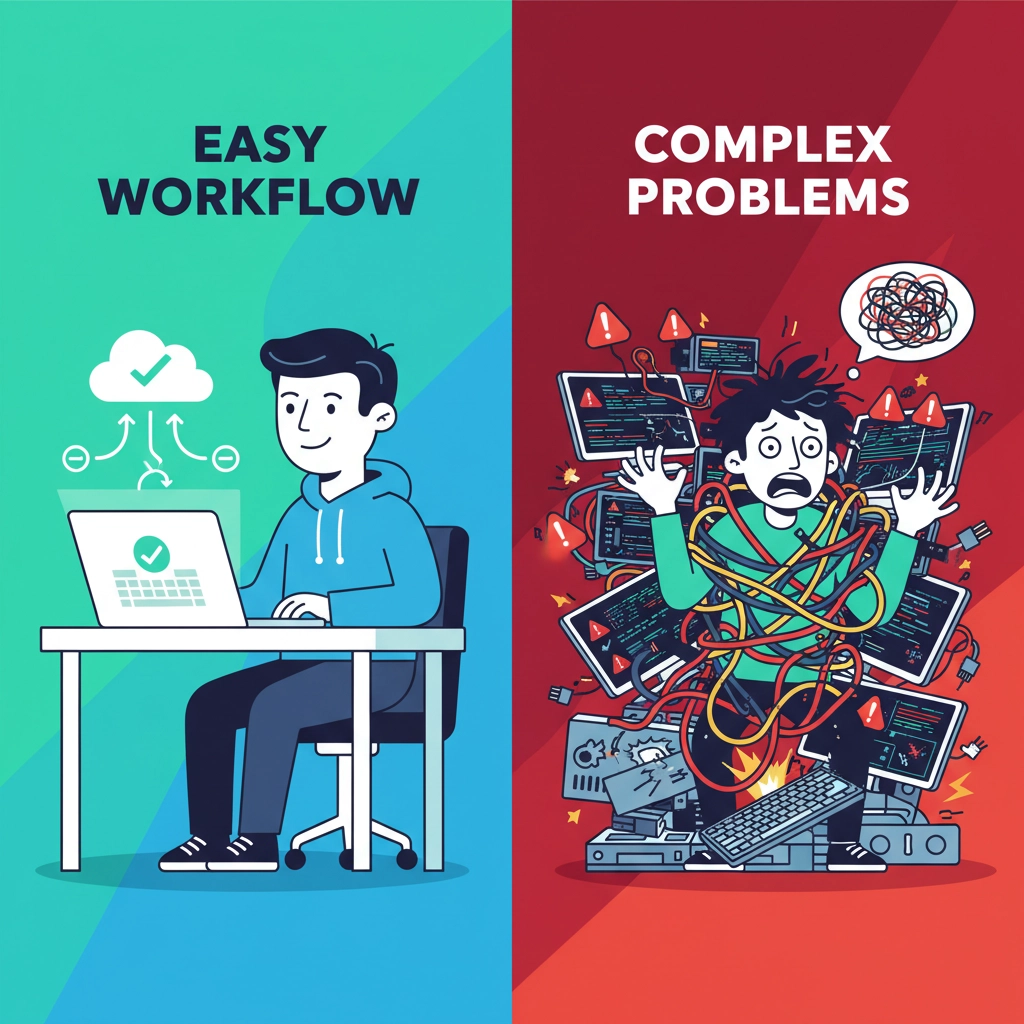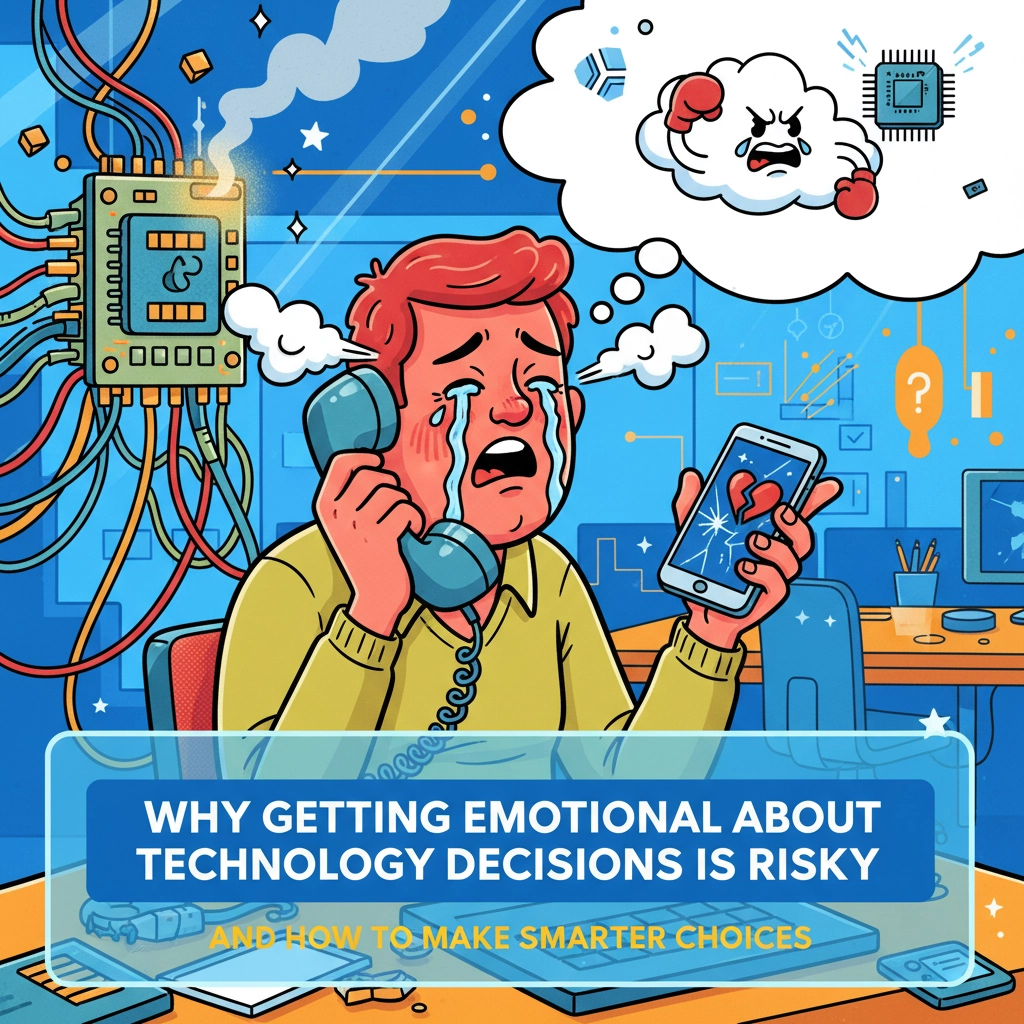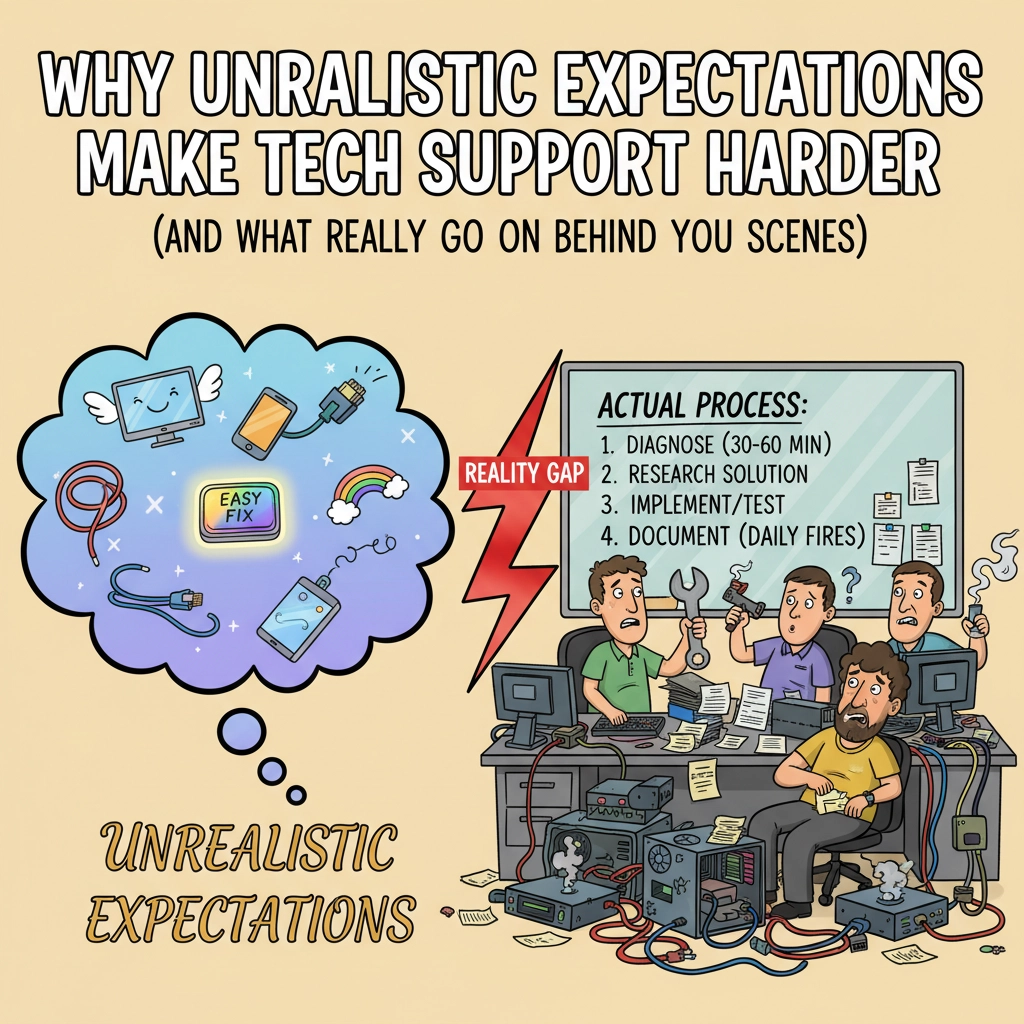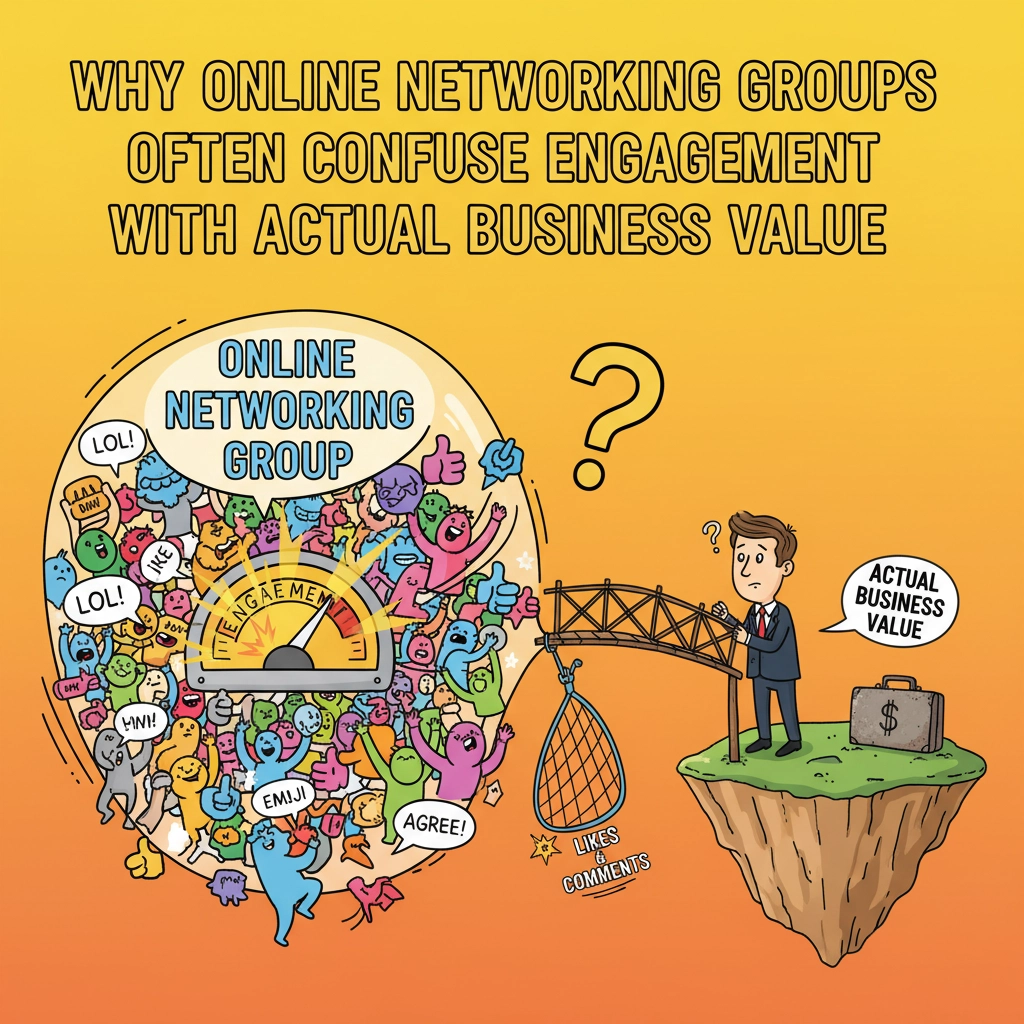Every healthy business relies on outside experts, IT, marketing, legal, finance. The difference between owners who get results and owners who burn money isn’t vendor quality. It’s the owner’s ability to receive and act on help.
Why Support Fails (Across Any Industry)
It’s rarely a mystery:
- The Helplessness Loop: “I don’t understand this,” refusal to try simple steps, then blame when nothing changes.
- The Accountability Gap: Vendors depend on inputs you control, context, decisions, approvals, data. When those slip, outcomes do too.
- The Communication Fog: Vague tickets (“the site doesn’t work”), missing details, no screenshots, no steps tried.
You’re paying for expertise, not mind reading. Delegation isn’t abdication.
The Shift: From “Fix it for me” to “Partner with me”
Three behaviors change everything:
1) Engaged Participation
Show up with the pieces only you control: timely inputs, quick testing, decisions.
Bad: “My social media isn’t working.”
Better: “IG engagement dropped ~40% after switching from product to lifestyle posts. Analytics attached. Do we revert or refine?”
Bad: “Help with inventory.”
Better: “Software shows 50 units; physical count is 35 (twice this month). Here’s our receiving checklist and last two count sheets.”
2) Clear, Concrete Communication
Describe what you did, what you expected, what happened instead, and attach proof.
Marketing: “Our farmers won’t get ‘precision agriculture.’ Let’s use ‘smart farming’ and show 2 practical examples.”
Legal: “Hiring remote Sales Director (TX focus), $150K base + commission, 90-day probation, non-compete needed. Last template attached.”
Finance: “June revenue shows $45K; bank deposits are $52K. Could this be credit-card settlement timing?”

3) Systematic Accountability
Build tiny habits so the right inputs arrive on time, without drama.
- Finance: one folder for receipts, a 15-minute monthly review, standardized categories.
- Marketing: simple approval workflow + due dates.
- Ops/Consulting: document changes, test on a small slice, track outcomes.
Callout: Kill Decision Latency
Most delays are waiting for your decision, not technical blockers. End requests with a binary choice or a time-boxed next step: “Choose A/B by EOD; otherwise we ship A.”
Relationship Maturity (Know Your Stage)
- Chaos: Reactive, vendor-hopping, constant emergencies.
- Awakening: Starting to document and follow recommendations.
- Integration: Clear protocols, preventive habits, regular reviews.
- Partnership: Mutual accountability, shared metrics, proactive planning.
- Mastery: Vendors drive innovation; owner focuses on vision.
Your goal isn’t perfection. It’s graduating stages.
Boundaries That Make Work…Work
Expect from vendors: clear scope, known limits, response standards, documented recommendations, regular reporting.
Expect from yourself: timely responses, necessary access, decision authority, on-time payment, respect for expertise. Respond in the agreed channel (one ticket = one thread). Urgent ≠ new channel; urgent = priority tag in the same thread.
Push back when: requests exceed scope, timelines are impossible, ethics are fuzzy, or communication/reporting stays opaque.
Owner Commitments: Name an Owner of Record for each project. One person consolidates input and makes the final call. Conflicting feedback = stall.
Reasonable vs. Unreasonable
- Reasonable: “Send a screenshot,” “Try these 2 steps,” “Test on staging.”
- Unreasonable: “Disassemble enterprise hardware via email,” “Rewrite your legal strategy overnight without context.”
Match the ask to the risk: simple steps by you; complex/risky steps via call or onsite.
Callout: Emergency Triage
Not everything is P1.
P1: down/hard stop, $$ impact/hour → 1–2 hr response
P2: degraded function → same-day
P3: routine → 1–2 biz days
Label your ticket P1–P3 upfront so effort matches impact.
The Small System That Changes Everything
Daily (5 minutes): skim vendor messages; note any issues with 1–2 sentences.
Weekly (20–30 minutes): review open items, make decisions, unblock them.
Monthly (60–90 minutes): check metrics vs. goals, reconcile invoices to deliverables, capture lessons, reset priorities.
When the Vendor Is the Problem (…or You Are)
Fire the vendor if: deadlines slip repeatedly after clear expectations, scope creeps without discussion, reports are vague, ethics are off.
Own your side if: multiple vendors “fail” the same way, you ignore recommendations, you’re always late with inputs, or your requests are consistently vague.

Use AI Like a Power Tool, Not a Vendor
AI is great for speed and prep. It’s not a replacement for the humans who own your context, compliance, and systems. For most business owners, it’s faster and cheaper to use AI for quick understanding, then hand off to the right vendor for execution and troubleshooting.
Use AI for (non-technical, quick wins)
- Getting plain-English explanations (“What does SPF/DKIM do?”)
- Drafting first passes (emails, briefs, checklists, FAQs)
- Summarizing long docs or meetings you’ll discuss with a vendor
- Brainstorming options/questions to bring to your expert
- Turning your screenshots/notes into a clean ticket
Don’t use AI for (call your vendor)
- Live troubleshooting of your stack (email auth, ERP, payroll, firewall rules)
- Legal/financial decisions, compliance, HR risk
- Security-sensitive workflows (credentials, PII, contracts)
- Anything that needs your company history, integrations, or SLAs
The 60-Second Rule
If AI can’t give you a confident, actionable outline in ~60 seconds without asking for sensitive data, stop and loop in your vendor.
Three Quick Checks Before You Trust AI
Context: Does this require knowledge of our unique setup or history?
Risk: Could this advice break something, violate policy, or create liability?
Ownership: Would my vendor be accountable for this step in our scope?
If any answer is “yes,” use AI only to prepare: then hand off.
Handoff Workflow (AI → Vendor)
Ask AI to produce:
- Problem statement (one sentence)
- Expected vs. actual
- Steps tried (1–3 bullets)
- Evidence (screenshot/links)
- Clarifying questions for the vendor
Paste that bundle into your ticket or email and add your availability.
Copy/paste template:
“Context: I was doing ___ to achieve ___. Expected ___; got ___. Steps tried: 1) ___ 2) ___. Evidence attached. Based on AI prep, here are 2–3 paths. Which do you recommend? I’m available ___.”
Security & Privacy Note
Never paste credentials, customer PII, contracts, or internal playbooks into public AI tools. When in doubt, strip sensitive details or ask your vendor to review securely.
Stay in the Game: How to Pause Without Quitting
Disengaging is the costliest move you can make. It resets context, stretches timelines, and erodes trust. Frustration is normal; disappearing isn’t. Use this simple protocol to pause productively instead of quitting midstream.
The Frustration Protocol (5 minutes)
- Name the stop point: “I got to Step 3: password reset page.”
- State expectation vs. actual: “Expected login; got ‘SMTP auth failed.'”
- List what you tried (1–3 bullets): “Reset; different browser.”
- Attach evidence: 1 screenshot or short Loom.
- Signal next availability: “I can try again today 2–3pm or tomorrow 10–10:30am.”
Callout: Don’t Ghost the Thread
If you can’t act yet, don’t disappear. Send a 90-second MVU (where you stopped, what blocked you, screenshot, next availability). Engagement beats silence every time.

Red Flags You’re Quiet-Quitting (Catch Yourself Early)
- You’ve repeated “I’m busy” twice without sending any evidence.
- You’re waiting for vendor “magic” instead of sending a 90-second MVU.
- You dread opening the thread: so you don’t. (Send the MVU; momentum returns.)
- You “try to do something on your own” or circumvent what the vendor asked: usually going beyond guidance, which can derail progress.
One Page You Can Use (Keep this handy)
Before you ask for help, confirm:
- The specific goal or problem in one sentence
- What you already tried (1–3 bullets)
- Evidence attached (screenshot, link, numbers)
- What “success” looks like
- Your availability for follow-up
- The decision you’re ready to make next
Ticket/message template (paste this):
“Context: I was doing ___ to achieve ___.
Expectation vs. Actual: Expected ___; got ___.
Steps tried: 1) ___ 2) ___ 3) ___.
Evidence: [link/screenshot].
Success = ___.
Next availability: ___.”
The ROI of Being a Good Client
Immediate: faster fixes, lower costs, less stress.
Long-term: vendors bring you their A-team, share strategic insights, and help you compound advantages.
Whether you’re working with cybersecurity consultants, web designers, or managed service providers, these principles apply universally. The best outcomes happen when business owners show up as engaged partners, not passive recipients of services. Your vendors: from IT support to marketing agencies: can deliver exponentially better results when you master the art of productive collaboration.
Share this:
- Click to share on Facebook (Opens in new window) Facebook
- Click to share on Tumblr (Opens in new window) Tumblr
- Click to share on X (Opens in new window) X
- Click to share on Pocket (Opens in new window) Pocket
- Click to share on Pinterest (Opens in new window) Pinterest
- Click to share on LinkedIn (Opens in new window) LinkedIn




